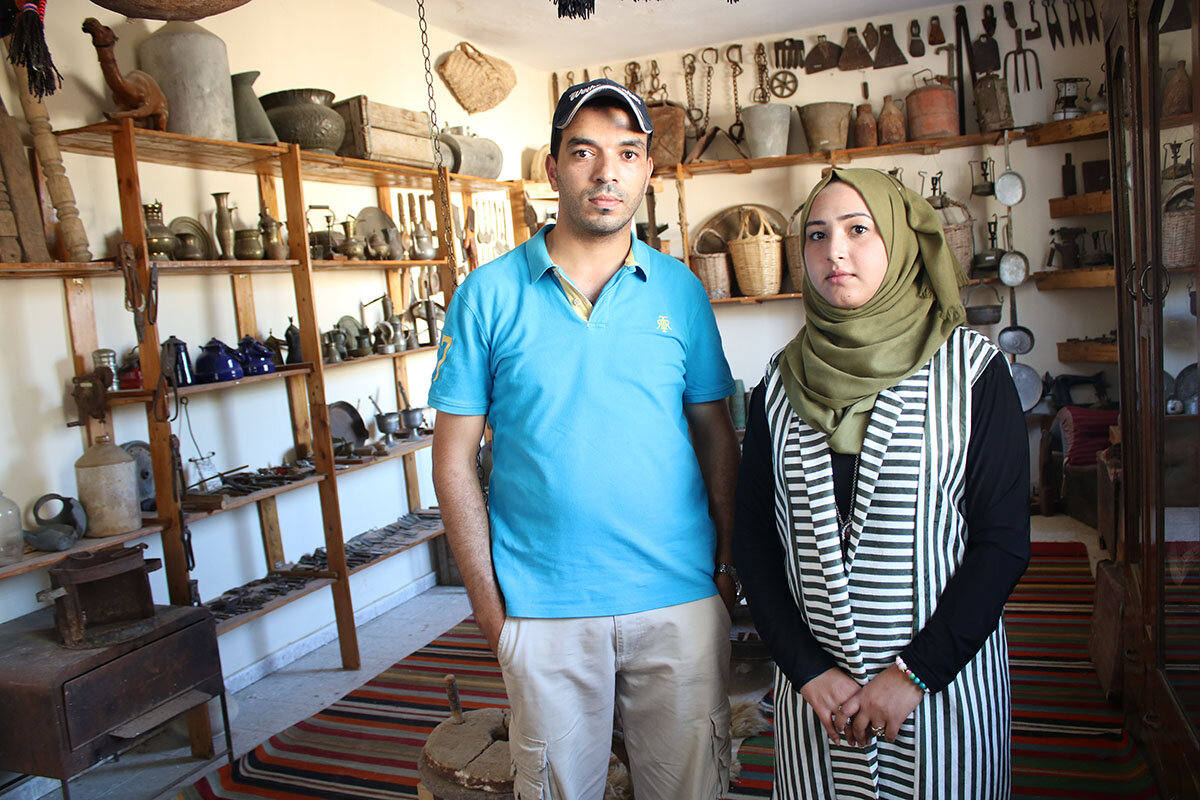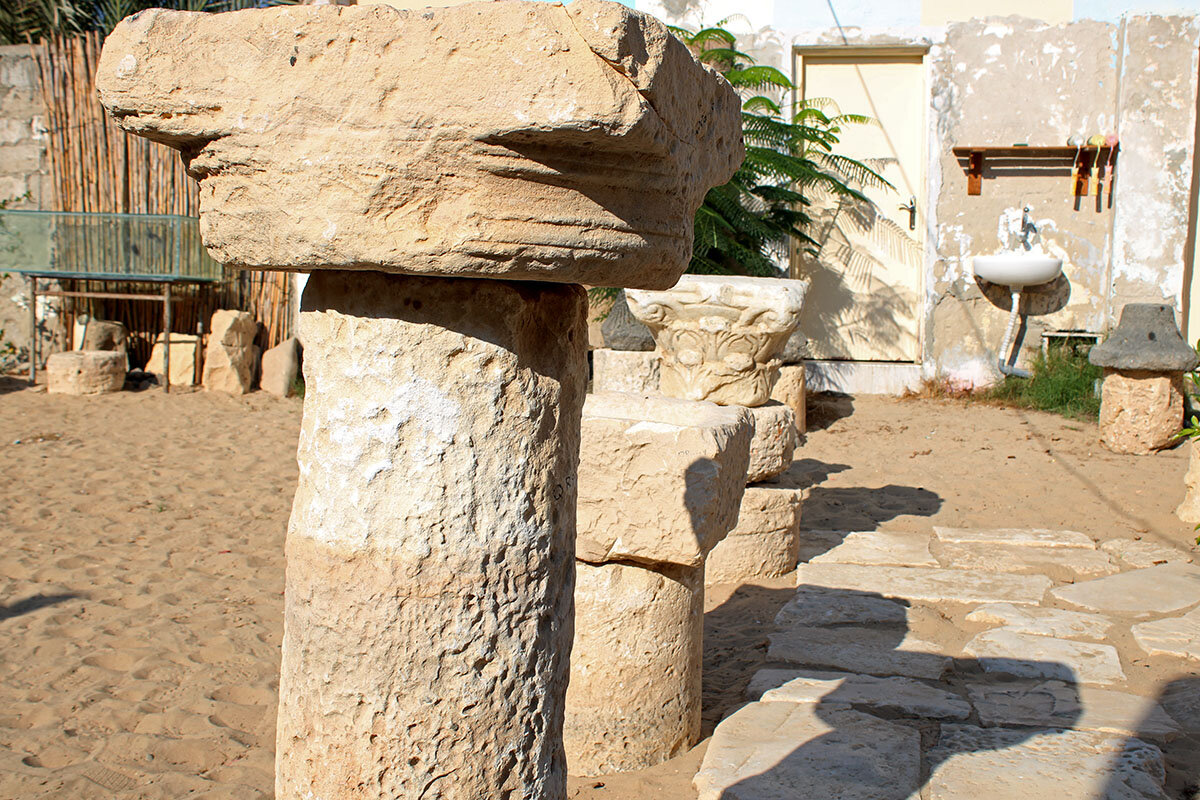In Gaza, a museum filled with history ‘picked up’ along the way
Loading...
| AL QARARA, Gaza Strip
On a small hilltop in central Gaza, a mile and a half from the Israeli border, lies a gateway to the past, and, some say, a modern-day cultural safe haven.
At the Al Qarara Cultural Museum, artifacts from six millennia stand side by side: Canaanite pottery, Roman coins, Byzantine mosaics, Crusader swords, turn-of-the-19th-century farming equipment, copper cookware, and traditional embroidered Palestinian thobe dresses.
Today, like any day, families, university students, and schoolchildren on a field trip and the odd passerby stroll past the displays showcasing a diverse history that pieces together what it means to be a Gazan.
Why We Wrote This
The Gaza Strip’s first private museum holds more than artifacts from six millennia of local culture. On display are the ingredients of identity – and a sense of belonging to the land.
“Art and archaeology help interpret the past and provide us with a new insight,” says 20-something Mohamed Abu Said, while browsing the museum with his friend Shahad Safi. “My visit reshaped my understanding of Gaza’s history and a unique cultural identity I am really proud of.”
Says Ms. Safi, “We should all be aware of our history in order to defend our right of being on this land.”
The initiative, Gaza’s first private museum and the second museum in the entire Strip, is the brainchild of Mohamed and Najla Abu Lahia, archaeology and culture enthusiasts who have long collected items of Gazan heritage and history.
The young couple decided to document, preserve, and display artifacts from a land that, despite capturing headlines for war, a blockade, and Hamas-Israel rocket fire, is literally bursting with history.
Mr. Abu Lahia first became interested in antiquities as an 8-year-old in Al Qarara by finding bits of pottery shards and stones on the ground on his way to school and back. Al Qarara, until recently a farming village located 15 miles south of Gaza City, is a historical settlement on trade routes dating from the Bronze Age.
“I would stop many times on the way to school to look at strange, old items that I saw along the road. I fetched them on my way back home and would examine them in my room,” Mr. Abu Lahia says.
His wife studied art and archaeology at Gaza University, and used her studies to help document and piece together the items she and her husband collected.
With cooperation from the Palestinian Authority’s Ministry of Tourism and Antiquities, the couple traveled across Al Qarara and beyond, looking for donations for the museum’s collection. The response, they say, was overwhelming.
“Al Qarara’s inhabitants wanted to actively take part in the project, and they helped us find ancient artifacts that we have here today,” Mr. Abu Lahia says.
Embellished with minute stone carvings adorning the walls, and encircled with Roman Corinthian columns, the museum housing the trove of antiquities is a former grain silo that is now a destination for visiting delegations, families, and school trips.
The Gaza Strip, a pivotal trade and migration crossroads between ancient Egypt, North Africa, and the Levant, was a key port and maritime trade center on the Mediterranean touched by many civilizations.
The collection begins with the Chalcolithic period from 4000 B.C., and then on to the Canaanites, the Bronze Age civilization that lived in Gaza and much of the region encompassing modern Israel, the Palestinian territories, Jordan, and Lebanon in the second century B.C.
Later eras showcased include the Roman, Byzantine, early Islamic, and Ottoman empires.
But visitors also gravitate to the modern-day collection of wooden plows, horse saddles, hand-woven baskets, and wooden and copper plateware, pitchers, and pots used by their grandparents only two generations ago.
The couple and the six other co-founders of the museum hope to take a traveling exhibition abroad to show the world another side to Gaza.
“We aim to send out a message that this tormented part of Palestine is not only a name synonymous with an image of violence, wars, blockade, and political unrest, but also a place of a long and rich history that is worth seeing,” says Isam Abdel Ghafour, a museum board member.
Through it, the museum’s founders hope to offer a counternarrative on Gaza, one linking past civilizations to the territory’s current inhabitants, and emphasizing Gazans’ rights to a contested land marred by modern politics and war.
Yet the blockade of the Strip and ongoing travel restrictions imposed by Israel on Gaza residents mean that the Abu Lahias and their collection dating back thousands of years cannot leave the Strip, take part in exhibitions, or reach an audience beyond Gaza. For now, the Abu Lahias and museum staff are focusing on the local community.
Plans are in place to expand the museum with funds from the A.M. Qattan Foundation, a Palestinian cultural and educational nonprofit organization based in Ramallah, in the West Bank.
Although government officials admit that they lack the “funds and resources” to support the private initiative, they are offering their moral support to help bring history alive to the young generation of Gazans.
“We would like to attract our young people’s attention to their heritage and to take ownership of it and save it,” says Hiam el-Bitar, a researcher at the Tourism and Antiquities Ministry.
“It is not just history,” Ms. Bitar says. “it is an integral part of our national identity.”








